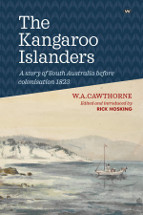The Kangaroo Islanders by W.A. Cawthorne, edited by Rick Hosking

Wakefield Press, 2020. ISBN: 9781862546554.
(Senior secondary - Adult) Highly recommended. Cawthorne's original
story, written in the mid-1850s, although a fictional account of the
murder of Captain George Meredith serialised for a Melbourne
magazine, is based on real people and events in the early 1800's. It
thus provides fascinating insight into the lives of early settlers
on Kangaroo Island, rugged Robinson Crusoe types, carving out an
existence dealing in seal and wallaby skins, living rough and free,
and collecting extra bounty from shipwrecks lured too near their
coast. With multiple 'wives', they were men who stole Aboriginal
women in so-called Sabine raids of the mainland and kept them in a
relationship of slavery, dependent on the women's hunting and
foraging abilities. Practices such as thigh and ear slashing kept
the women submissive; however there are examples of a certain
respect and admiration for some individuals such as Black Bet, and
Cawthorne even writes how much more valuable such a talented wife
would be over some civilised lady of polite society who could only
be a hindrance in such an environment.
One chapter reveals the bounty of Indigenous food enjoyed by the
Islanders, baked wild dog, goanna in wallaby fat, ant eggs, heart of
the grass tree, and witchetty grubs. The garments of the men become
indistinguishable from those of the women, with skins and furs slung
around their bodies. Past readers of this tale must have been
fascinated by all these exotic details, and they are even more
valuable now, providing us with a historic record of a much
forgotten past.
This publication of Cawthorne's story is much enhanced by the
extensive notes and explanations by researcher and editor Rick
Hosking. The subtleties of the text are revealed to us, lost
meanings revived, so we too can appreciate what was probably the
first Aboriginal joke in print, among many other insights. Hosking's
essay 'Beyond the pale' provides historical context and an in depth
analysis of the complexities of the relationships revealed in the
story that could fuel many an interesting discussion for students of
Australia's colonial history.
The book also includes a selection of watercolours by Cawthorne, now
held in the State Library of NSW, providing an enduring archive of
scenes of Aboriginal life.
All in all, this book preserves a valuable historical record and a
reminder of a past that Australia as a nation seems too ready to
gloss over and forget. Thanks is due to Wakefield Press for their
commitment to publication of outstanding South Australian research.
Helen Eddy